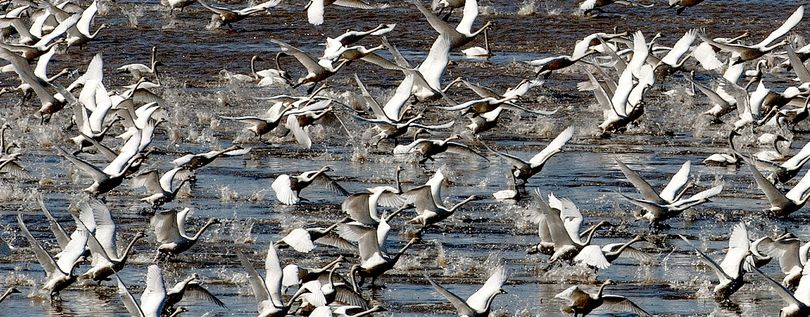Top 10 ways to help birds this spring

WILDLIFE WATCHING -- Spring migration is kicking into high gear as birds move, sometimes for thousands of miles, from wintering areas to settle into their breeding territory.

Birders know the beauty and excitement of the migrations also must be balanced with concern for the birds during this vulnerable period. Dr. George Fenwick, President of American Bird Conservancy, says, “Spring is a deadly time for birds for three big reasons. Scientists estimate that 300 million to one billion birds die each year from collisions with buildings, many during arduous migrations in unfamiliar environments. Up to 50 million die from encounters with communication towers and up to six million may die each day from attacks by cats left outdoors. These deaths occur year-round, but many occur during spring and fall migration.”
“Some studies suggest that perhaps as many as half of all migrating birds do not make it back home,” he said, “succumbing to various threats on either end of the journey.”
One in five Americans engage in bird watching. That's enough people-power to have an impact in reducing the fatalities.
Read on for ABC's list of 10 ways to hep birds this spring.
TOP TEN WAYS TO HELP BIRDS THIS SPRING
1. Keep your cat indoors. This is best for your cat as well as for the birds, as indoor cats live an average of three to seven times longer. Cats are responsible for an estimated 2.4 billion bird deaths each year. In the spring, young birds or nestlings often end up on the ground, attracting the fatal attention of a nearby cat. Ground nesting species that are especially vulnerable include Killdeer and Wood Thrush, but all baby birds—from ducks to warblers—will be on the ground for a critical period of time.
2. Prevent birds from hitting your windows. As many as one billion birds die each year after colliding with glass in buildings. You can reduce this problem at your home by applying a variety of window treatments. For example, ABC BirdTape is a proven solution that is inexpensive and long-lasting. (See a short video here.) Birds most prone to fatal collisions at home windows or glass doors include Ruby-throated Hummingbird and Wood Thrush.
3. Eliminate pesticides from your yard. Even those pesticides that are not directly toxic to birds can pollute waterways and reduce insects that birds rely on for food. For rodent control, seal cracks, remove food sources, and use snap and electric traps rather than rodenticides, which can poison raptors such as hawks and owls as well as young children. And be sure not to garden with neonicotinoid-coated seeds, or neonics, which are lethal to songbirds as well as to bees and other invertebrates. Learn more here.
4. Buy organic food and drink Smithsonian-certified Bird Friendly Coffee. Going organic helps to reduce pesticide use on farms and increases the market for produce grown without the use of pesticides, which can be toxic to birds and other animals, and will help to reduce the use of these hazardous chemicals in the U.S. and overseas. Shade coffee farms have been shown to provide far superior habitat for birds than coffee grown in open sun. Buying coffee that is certified Bird Friendly is one of the easiest ways to help migratory birds.
5. Create backyard habitat using native plants. When you garden with plants that evolved in your local habitat, you supply native insects and their larvae with food, which in turn are an irreplaceable food source provided by birds to their nestlings. Yards both large and small can benefit birds and other wildlife. Create a diverse landscape by planting native grasses, flowers, and shrubs that attract birds. You will be rewarded by their beauty and song, and will have fewer insect pests as a result. Read more here.
6. Reduce your carbon footprint. While all forms of energy use impact birds, small individual actions can add up and make a difference. Use a hand-pushed or electric lawnmower, carpool, and use low-energy bulbs and Energy Star appliances. Less energy used means less habitat destroyed for energy production.
7. Donate old bird-watching equipment. Binoculars or spotting scopes will be appreciated by local bird watching groups—they can get them to schools or biologists in other countries who may not have the resources they need. More people studying birds means more voices for bird conservation!
8. Keep bird feeders and bird baths clean. If you feed the birds, make sure you aren’t accidentally allowing the spread of disease. Disinfect feeders and bird baths, and change water regularly or use a drip system to prevent mosquitoes from breeding.
9. Support bird-friendly legislation. U.S. policy makers frequently make decisions that affect birds. For example, decisions are now being made that will impact the survival of the imperiled Greater Sage-Grouse. By raising your voice, you can help to influence the outcome for birds on this and other important issues.
10. Join bird conservation groups. Good examples locally are the Spokane Audubon Society and the Coeur d'Alene Audubon Society. Nationally, check out American Bird Conservancy. Your support will provide needed dollars for bird conservation, enabling you to help achieve more than is possible through individual efforts. Membership also enables you to become more informed and involved in the issues you’re concerned about.
